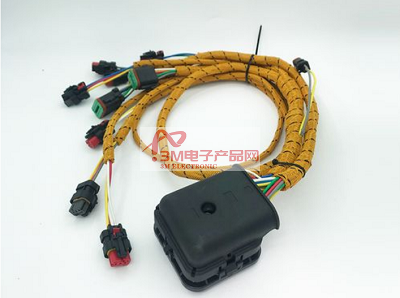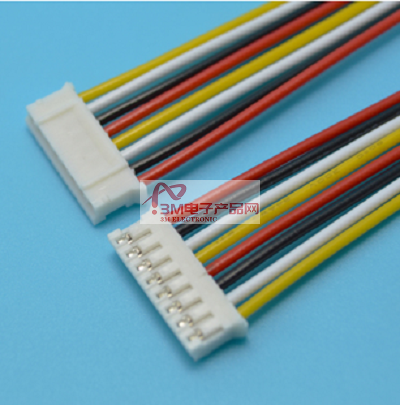Categorization:Product Information
Wiring Harness Manufacturing Process OverviewThe HXN5 locomotive has approximately 30 wiring harnesses, of which the harness consists of approximately 1,000 wires of various lengths and sizes, which need to be lifted by a crane. The wiring harness manufacturing process shall include the preparation of: wiring harness materials (including wire 2, terminals, connectors, bundling tape, wire numbering labels, insulating tapes, heat-shrinkable tubing, etc.). , the preparation of work tools (crimping machine, heat shrink machine, scissors, test equipment, etc.). , as well as offline stripping, wire numbering, terminal crimping, connector assembly, wiring binding, harness testing and harness finishing, key technologies 2.1 Terminal Crimping Terminals are used to connect wires and instrumentation. Wired power and signals flow into or out of instruments and equipment through the terminals. Whether the quality of terminal crimping meets the requirements of the relevant standards is directly related to the normal operation of instruments and equipment. A terminal should be composed of two parts, the plug area, the transition area and crimp area crimp quality problems are as follows: 3.1.1 crimp height is too large or too small crimp height is crimped after the guide body crimp area cross-section and height, which is a good crimp * * * * important features. Too high crimp height can not effectively compress the wire core, will cause too large crimp area invalid gap. Due to the insufficient amount of metal between the wire and the terminal metal, the contact resistance will increase, resulting in terminal heating and burnout. If the crimp height is too small, the cable pull and current rating will be reduced and the wire core will be crushed or the crimp area of the terminal will break, which will break the wire connection and cause the circuit to be disconnected. Check the quality after crimping with a special gauge such as a micrometer and check the crimping pliers and crimping equipment frequently to ensure the quality of terminal crimping.2.1.2 Insulation crimping zone is too small or too large Due to the many types, sizes and terminal types of conductors, there are no uniform regulations, and experience can only be gained in actual operation. Insulation crimping is to give the conductor crimping zone, provide stress relief so that when the cable is laid, the conductor crimping zone will not break due to the cushioning of the insulation crimping zone. Therefore, a good insulation crimp plays an important role in protecting the conductor crimp. The metal stress in the insulation crimp area will be too large due to too small an insulation crimp, which will weaken its stress relief function, and too large an insulation crimp cannot effectively cushion the conductor's stress relief. Observed with the naked eye, gently shaking the wire by hand, the insulation crimp area will not shake!

2.1.3 Loose wire crimping zone Loose wire crimping is one of the *** common quality problems in the terminal crimping process and the main reason for crimping failure. All wire cores are not fully encapsulated in the conductor crimp zone, in, so the strength and current loading capacity of the crimped parts will be greatly reduced. Simply regather the cable into bundles and insert them into the terminals to be crimped. Stripping the insulation from the cable is a separate operation and the cores may be accidentally separated during processing or bundling. When stripping the wire with logger pliers and keeping the insulation removed to the proper length without the insulation coming off, the insulation sleeve will not be completely removed from the cable until it is ready to be crimped to the cable with the terminals, which will help to minimize the problem of loosening of the cores to ******.2.1.4 Stripping Lengths Too ShortWhen stripping, it is important to ensure that the stripping lengths are moderate. If the stripping is too short, when the terminal is crimped, the conductor cannot be inserted into the conductor crimping area, and the crimping force between the terminal and the conductor does not meet the requirements of the tensile test, and therefore the conductor is prone to fall off due to vibration during locomotive operation. As the contact between the conductor and the terminal, is reduced, the heat here will be great and a circuit break may occur. Therefore, a sufficient stripping length should be strictly ensured and the conductor should be inserted as far as possible into the crimping zone during the crimping process.2.1.5 Cable inserted too deepContrary to 3.1.4, if the conductor is inserted too far into the transition zone, the pins may not be inserted correctly due to the conductor core being too long, resulting in poor contact of the conductor between the two connectors and interruption of the signal. Another type of failure often occurs when a wire is inserted too long, resulting in a short circuit between the two wires. This situation has led to numerous machine failure incidents with locomotive traction motor speed sensor connectors. The way to eliminate this quality problem is to strictly require that the stripped wire length should not be too long, and to pay attention to maintaining a moderate amount of wire insertion when crimping the wires.2.2 Connector AssemblyConnector assembly should be captured in the following keys to connect:2.2.1 There are many types of locomotive connectors, many of which are similar in appearance, but the internal structure is completely different. When assembling, the material should be taken in strict accordance with the material rack code. Upon receipt of the material, it should be strictly compared with the operating instructions.3.2.2 Grasp the proper force when inserting the terminal into the connector jack. When you hear a "clicking" sound, the terminal cannot be inserted correctly. At this point, you cannot continue to apply force. There are many quality problems in the field because the operator can only judge the insertion position by the appearance 2.2.3 Assembled connectors should be protected. Connectors are mainly used for locomotive signal and control wires. Dust and air moisture from the production site can intrude into the connectors and cause short circuits between adjacent lines, seriously affecting the normal control of locomotives and vehicles. Use the protective cover of the connector to cover the whole connector and tighten it to ensure the quality of the organization.2.3 Wiring BindingThe wiring harness is a neural network connecting different parts of the locomotive equipment, so the wiring harness manufactured should be connected to the instrumentation on the locomotive. When wiring, the bundle is strictly bound in the direction of the line specified by the terminal board. Only one binding tape can be used for cross-binding at intersections to effectively prevent the wiring harness from loosening.

2、About 3M electronic products network platform related to the introduction and sales of products briefly: 3M electronic products network - a professional agent / production / sales of a variety of {connectors | wiring harness | wire and cable products }; if you have a related [connectors | wiring harness | wire and cable products] purchasing / sourcing needs or would like to buy / to understand which connectors | wiring harness | wire and cable products we can provide solutions, please contact our business staff below; if you have a related [connectors | wiring harness | wire and cable products] sales / resources and promotion needs, please click "→ Business Cooperation ← with a dedicated person to discuss! If you have related [connector | wire harness | wire and cable production] sales / resources and promotion needs, please click on the "¡¡ Business Cooperation ←" to discuss with a person!